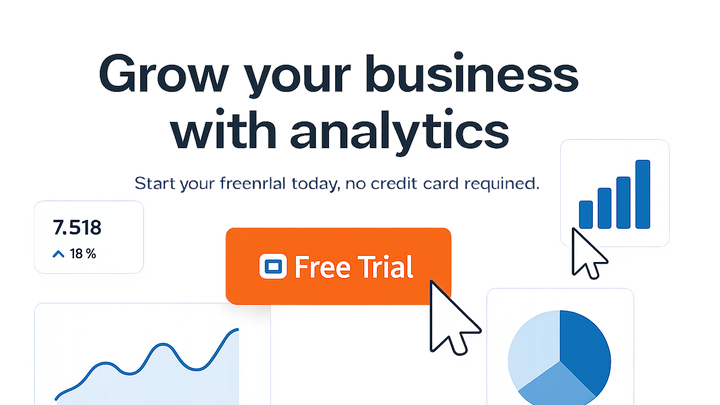Published on 2025-06-29T20:07:29Z
What is a Free Trial CTA? Examples & Best Practices
A Free Trial CTA (Call to Action) is a prominent button or link on a website inviting visitors to start a risk-free trial of a product or service. In CRO (Conversion Rate Optimization), UX (User Experience), and SEO (Search Engine Optimization), an optimized Free Trial CTA can dramatically boost lead generation, reduce bounce rates, and improve on-site engagement metrics. By offering users a no-commitment way to experience your solution, it lowers the barrier to entry and showcases value before purchase. For example, Prevue.me uses its Free Trial CTA “Get Your Free Website Audit” in the hero section, paired with action-oriented copy and a contrasting color to drive sign-ups. Effective design, copy, placement, and timing of your Free Trial CTA guide users toward conversion, enhancing both user satisfaction and business results.
Free trial cta
A Free Trial CTA invites users to start a trial, boosting conversions by offering risk-free access to your product or service.
Definition and Purpose
Clarifies what a Free Trial CTA is and why it’s a key element in the digital marketing toolkit.
-
What is a free trial cta?
A website element (button or link) that prompts visitors to sign up for a free trial period without upfront payment.
-
Role in the user journey
Serves as the bridge between initial interest and paid conversion by lowering perceived risk and demonstrating product value.
Importance in CRO, UX, and SEO
Explores how an optimized Free Trial CTA impacts conversion rates, user satisfaction, and search performance.
-
Cro impact
A clear, compelling Free Trial CTA can significantly increase click-through and trial sign-up rates.
-
Ux impact
Strategic placement, intuitive design, and concise copy enhance usability and reduce friction.
-
Seo impact
Indirectly boosts SEO by improving engagement metrics (dwell time, pages per session) that search engines favor.
Best Practices for Free Trial CTAs
Actionable guidelines to craft CTAs that attract clicks and convert visitors into trial users.
-
Placement
Position CTAs above the fold, in the header, and at logical breakpoints (e.g., end of feature lists) for maximum visibility.
- Above the fold:
Ensure the primary CTA is visible without scrolling.
- Contextual placement:
Place secondary CTAs near relevant content like testimonials or feature descriptions.
- Above the fold:
-
Copywriting
Use action-focused, benefit-driven language (e.g., “Start Your 14-Day Free Trial”) to clearly convey value.
- Use numbers:
Specify trial length to set user expectations.
- Highlight benefits:
Emphasize what users will gain during the trial.
- Use numbers:
-
Design
Apply contrasting colors, ample white space, and accessible typography to make the CTA stand out.
- Contrast:
Ensure the button color pops against the background.
- Size & spacing:
Make buttons large enough to click comfortably and surrounded by whitespace.
- Contrast:
-
Urgency & incentives
Incorporate time-limited offers or risk-reversal statements (e.g., “No Credit Card Required”) to reduce hesitation.
- Time-sensitive copy:
Use phrases like “Limited Time Offer” to spur action.
- Risk reversal:
Include statements like “Cancel Anytime” to alleviate concerns.
- Time-sensitive copy:
Implementation Examples
Real-world Free Trial CTAs from leading SaaS platforms, illustrating varied approaches and designs.
-
Prevue.me
Features a bright orange “Get Your Free Website Audit” button in the hero section, highlighting actionable critiques for CRO, SEO, UX, and accessibility.
-
Slack
Uses a minimalist “Try for Free” button in both the top navigation and hero area, emphasizing team collaboration benefits.
-
Dropbox
Offers a “Sign up for free” CTA with simple, supportive subtext and minimal form fields to streamline onboarding.
Measuring and Optimizing Performance
How to track, test, and refine your Free Trial CTAs for continuous improvement.
-
Key metrics to track
Monitor click-through rate (CTR), trial sign-up rate, activation rate, and engagement during the trial.
- Ctr:
Percentage of visitors clicking the CTA.
- Trial sign-up rate:
Ratio of visitors completing the trial signup.
- Activation rate:
Users who perform a key action (e.g., create a project) during the trial.
- Ctr:
-
A/b testing
Experiment with variations in copy, design, placement, and incentives to identify the highest-performing combination.
- Hypothesis:
Define the expected impact of your change.
- Test variants:
Create and compare at least two versions.
- Sample size & duration:
Run tests long enough to reach statistical significance.
- Hypothesis:
-
Iterative improvements
Leverage heatmaps, session recordings, and user feedback to refine CTAs based on real behavior.
- Heatmaps & recordings:
Identify where users click and scroll to optimize placement.
- User surveys:
Gather direct feedback on the CTA’s clarity and appeal.
- Heatmaps & recordings:
